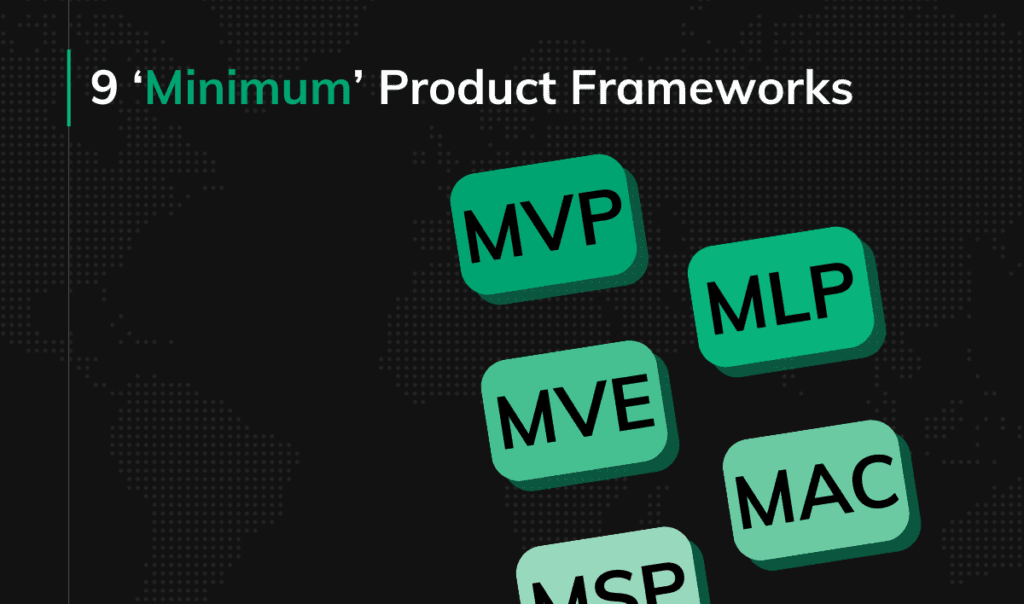19 must-know digital healthcare market trends for 2026
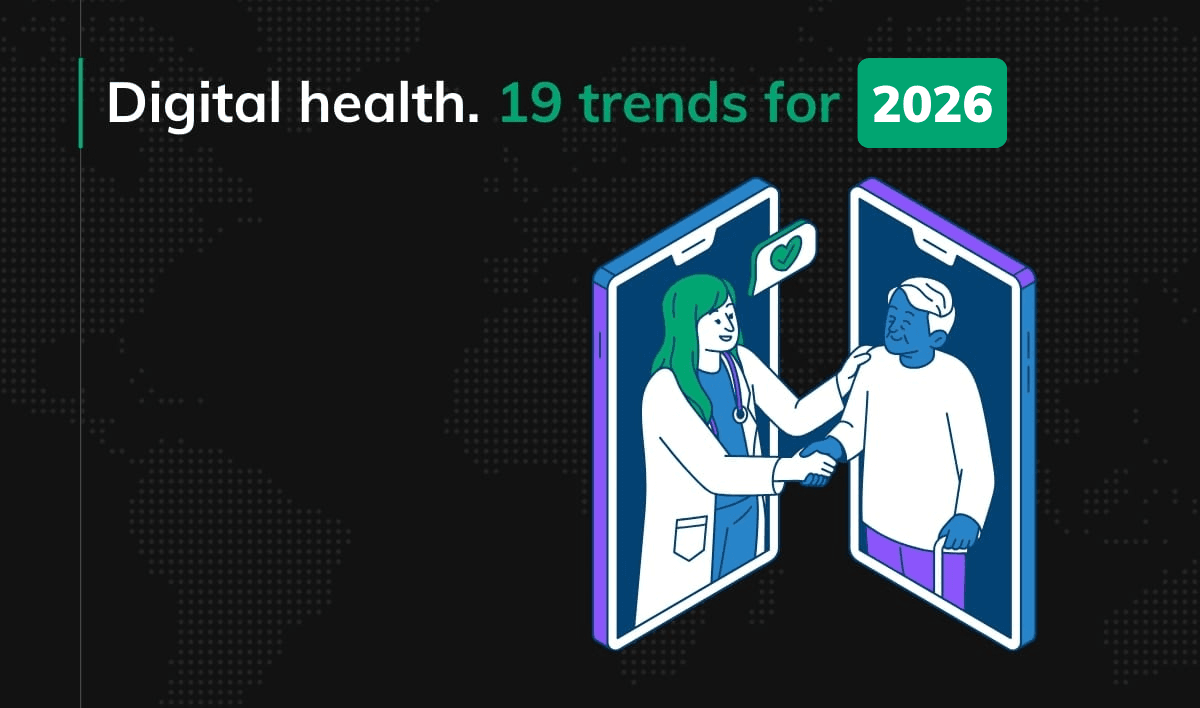
It’s a dense, information-packed, 20-minut read. Yet, once you’ve finished it, you can be sure you know the modern digital health landscape inside-out.
2025 will be the year health tech predicts the future.
AI will anticipate our needs, wearables will alert us before symptoms appear, and virtual care could outperform in-person visits.
Ready to lead the charge? Here are 19 trends shaping digital health now—insights to help you stay pragmatic, strategic, and ahead of the curve.
LEVERAGE THESE INSIGHTS NOW
Digital healthcare market trends insights
The digital health market is booming, driven by new tech innovations and personalized healthcare services.
According to Statista, the global digital health market is expected to exceed a staggering $650 billion in 2025, fueled by mobile health, wireless health, and telemedicine solutions. Moreover, global digital health funding has surged significantly, reaching over $22 billion in 2020 (compared to around one billion U.S. dollars in 2010).
One of the most established digital health trends is eHealth, including electronic medical records (EMR) systems. The adoption of EMRs among U.S. physicians has increased from 18% in 2001 to 88% in 2021, which shows the growing reliance on digital solutions in healthcare. The market value of EMRs is also projected to reach $47.2 billion by 2027.
The COVID-19 pandemic has further accelerated the adoption of digital health tools, particularly telemedicine. Telemedicine – virtual consultations between patients and physicians – has become a viable alternative for non-emergency medical services. The global market size for telemedicine is expected to reach nearly $280 billion in 2025, demonstrating the immense potential of this technology.
In addition to EMRs and telemedicine, patient-owned health data (POHD) is emerging as a huge digital health trend. European health professionals predict that POHD will play a pivotal role in shaping the future of eHealth. With POHD, patients can access, manage, and share their health data – one more evidence we’re moving into a hyper-personalized approach to treatment.
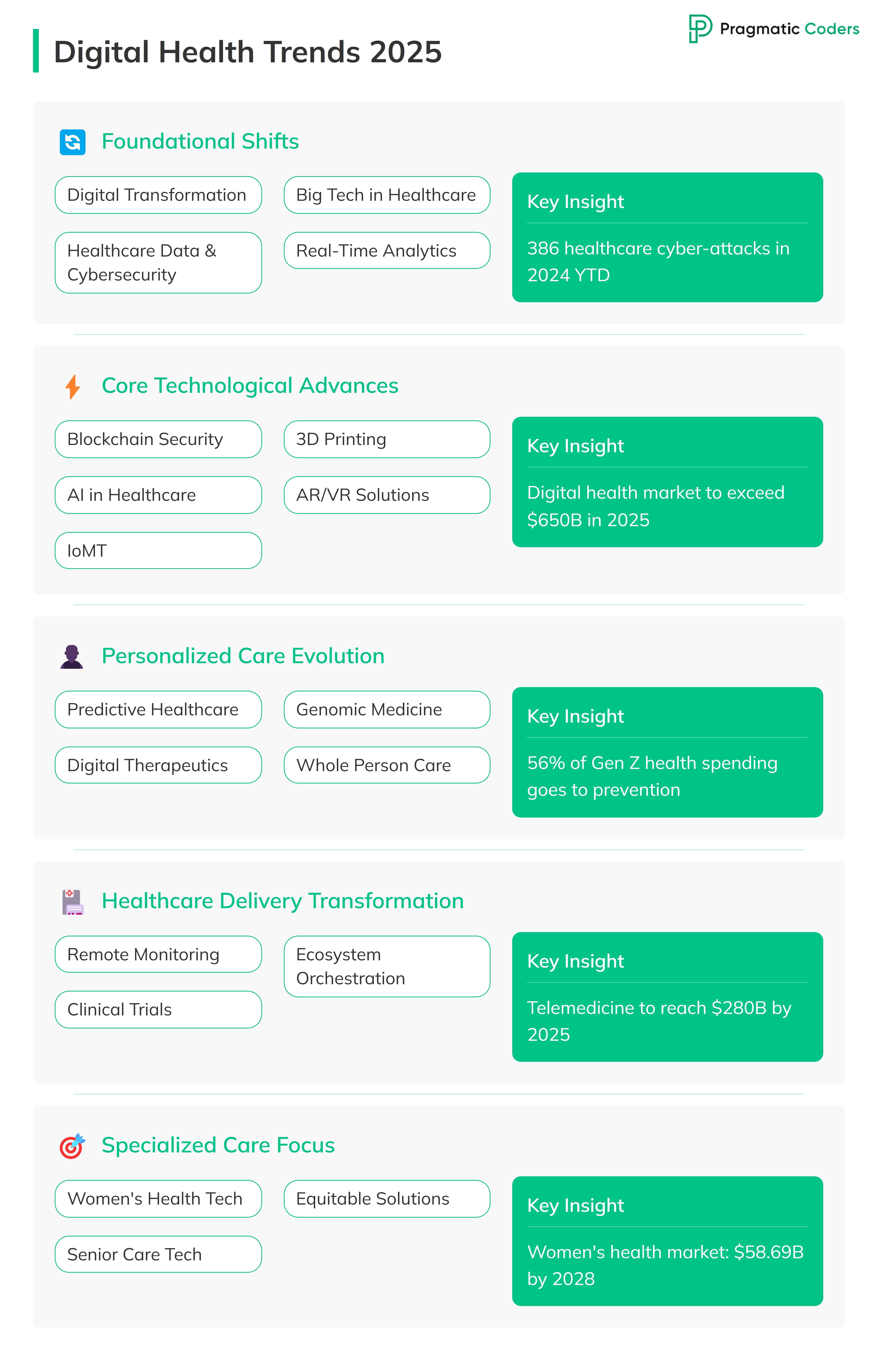
Foundational shifts | Digital healthcare market trends
1. Digital Transformation in healthcare (+A shrinking healthcare workforce)
The COVID-19 pandemic forced healthcare organizations to adapt to a new, digital reality. With in-person visits restricted, organizations had to find new ways to provide care to patients. This led to a rapid increase in the adoption of digital health solutions, such as virtual care, telehealth, and remote patient monitoring.
Digital health solutions offer many benefits for both patients and providers. For patients, they can provide convenient, affordable, and accessible care. For providers, they can help to improve efficiency, reduce costs, and improve patient outcomes.
However, some challenges still need to be addressed to accelerate the adoption of such healthcare solutions. These challenges include:
- Lack of interoperability between different healthcare systems;
- Security and privacy concerns;
- Lack of patient and healthcare provider awareness.
Despite these challenges, the future of healthcare is digital. Patients want convenient, omnichannel, contactless interactions like other industries provide.
While the transition won’t be instant, once triggered by the pandemic, more healthcare providers are expected to move soon.
Here are two examples of how digital solutions are being used to improve healthcare:
- Medi24 , a telemedicine healthcare company based in Switzerland, has developed a symptom triage tool that uses conversational artificial intelligence to help patients understand their symptoms and get the care they need.
- Doctor Anywhere , a telehealth startup in Singapore, offers an internet-based mental health video consultation service that allows users to connect with a therapist from their homes.
Learn more: Intelligent automation in healthcare
This trend correlates with another tendency we can observe: shrinking healthcare workforce.
The healthcare industry faces workforce shortages. Even before the pandemic, around 40% of practicing physicians experienced burnout weekly. Aging demographics and increased life expectancy intensify the healthcare professionals shortage even more.
How are companies addressing the change with healthcare technology?
- Value-based care. The healthcare sector must persist in refining care delivery models. Even though changing from fee-based to value-based care might not fix shortages right away, it could help decrease the need for healthcare workers in the future.
- Automation. Improving how certain parts of care are automated could let nurses dedicate more time to patients and less time to administrative or less important jobs. We can also foresee a rising trend in using digital health technology such as telehealth and electronic forms with online payments. These can help reduce the number of medical professionals needed for tasks in the back and front of the office during appointments.
- Artificial intelligence chatbots to replace/accompany healthcare professionals. AI-powered chatbots using language models can offer patients immediate interactive talks and various services, including booking appointments, getting prescriptions, and addressing inquiries around the clock.
Telehealth app development
2. Big Tech in Healthcare Ecosystem
Apart from investing massive funds into developing super-apps (all-in-one apps that bundle search, transaction, and delivery services), the Big Five (Meta, Microsoft, Amazon, Google, and Apple) utilize their technical proficiency and leverage extensive customer data to create innovative healthcare models.
Microsoft launched the Microsoft Cloud for Healthcare to provide integrated capabilities for streamlined workflows, advanced data analytics, improved patient engagement, team collaboration, and operational insights.
Similarly, Amazon introduced AWS for Health, a cloud services platform catering to clinical systems, analytics, AI/ML, patient experiences, research, finance, operations, and core health IT.
This trend is likely to result in two outcomes:
- The new competition will stimulate the “traditional” players in the healthcare landscape to enhance patient engagement strategies.
- BigTech companies will look to collaborate with conventional healthcare providers to manage the inherent intricacies of healthcare procedures.
3. Healthcare Data & Cybersecurity
While Education and Research continue to be the primary targets, the healthcare sector saw a big surge in attacks year-on-year. By October 2024, 386 health care cyber-attacks were reported thus far in 2024. Cybercrime seems to be unfolding at the same elevated rate as in 2023, which was the worst year ever for breaches in health care.
PwC expects more rules to be enforced, which could add more pressure to the healthcare industry’s already being strictly regulated. The increasing number of cyberattacks is one catalyst for adopting robust security strategies. Apart from that, healthcare organizations are eager to adopt better security measures because of the development of HIPAA privacy rules and FHIR standards.
- HIPAA, or the Health Insurance Portability and Accountability Act, establishes legal standards for safeguarding patient data, promoting cybersecurity in the healthcare industry by ensuring the secure storage and transmission of sensitive medical information.
- FHIR, or Fast Healthcare Interoperability Resources, sets standards for exchanging healthcare data electronically. FHIR provides a standardized collection of APIs, allowing healthcare systems to communicate and securely exchange data, akin to the mechanisms seen in open banking and PSD2 for financial services collaboration.
Learn more: HIPAA-compliant software development in 2025
4. Real-Time Health Analytics
According to Deloitte’s 2025 predictions, real-time health analytics has moved from experimental technology to an essential component of healthcare delivery. The ability to convert continuous streams of health data into actionable insights allows healthcare providers to make informed decisions faster than ever.
What’s making this possible? The convergence of connected medical devices that collect patient’s data.
Learn more: Data-driven healthcare
Today, real-time analytics is being applied in three key areas:
- Clinical Decision Support. Healthcare providers use real-time analytics to monitor patient vital signs and receive immediate alerts about potential complications. This enables early intervention before conditions become critical.
- Resource Optimization. Hospitals employ real-time analytics to manage patient flows or predict admission rates.
- Population Health Management. Healthcare organizations analyze real-time data to identify emerging health trends and track public health metrics, enabling faster responses to potential health threats.
The key challenge isn’t collecting data – it’s making it immediately useful. Healthcare organizations are focusing on processing data closer to its source, reducing latency and enabling truly real-time responses.
Core technological advances | Digital healthcare market trends
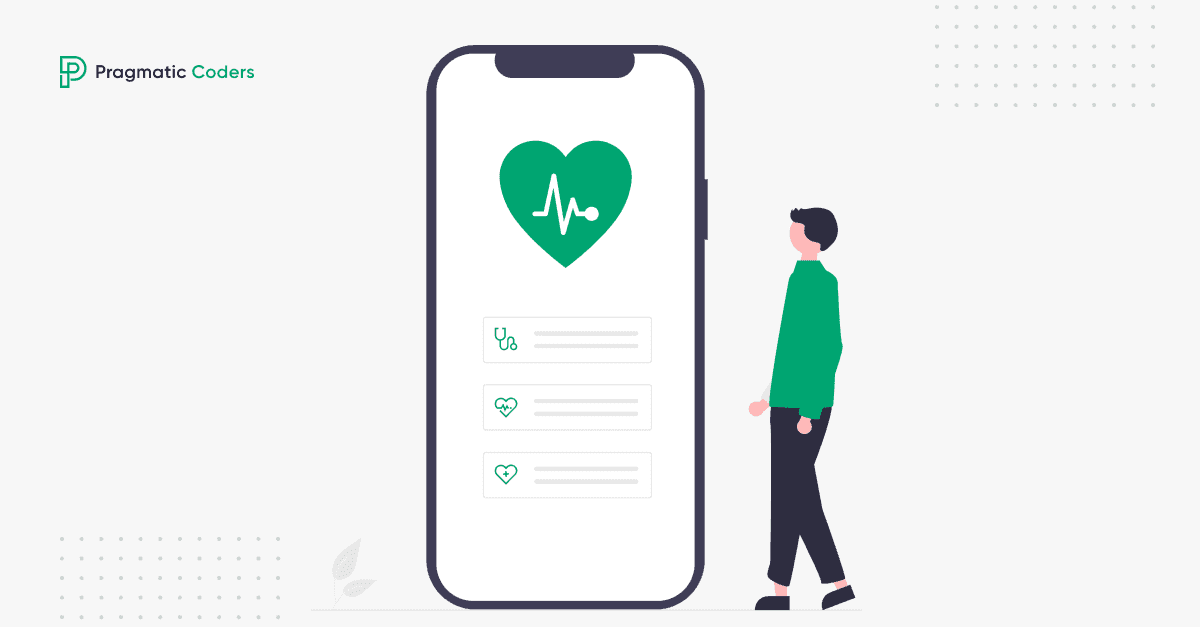
5. Blockchain and data Security
Blockchain is a decentralized digital ledger that records transactions across multiple computers. As such, it offers a secure and transparent way to store and share healthcare data:
- Secure Electronic Health Records (EHRs): Blockchain can be used to create secure and tamper-proof EHRs.
- Supply Chain Transparency: Blockchain can track the movement of medical supplies and pharmaceuticals, ensuring their authenticity and quality
Learn more: How-to guide to EHR integration
6. AI in Healthcare
Among these healthcare trends for 2025, one significant force stands out: the widespread integration of artificial intelligence.
Monitoring AI’s future impact isn’t just an option – it’s a must.
Here are three examples of how AI is being used in healthcare:
- Medical AI: AI analyzes medical images (X-rays, CT scans, MRIs) to detect diseases earlier and treat them quicker.
- AI drug discovery: AI accelerates drug development by analyzing genomic data and clinical trials to find effective and safe drugs faster.
- AI medical simulations: AI creates realistic simulations for training healthcare providers so that they can improve their skills in a safe environment.
A big future trend that’s going to define 2025 is AI agents. While everyone’s talking about AI chatbots diagnosing patients (spoiler alert: they’re not), something more interesting is happening in healthcare. Major tech players (Microsoft, Oracle, NVIDIA) and startups are taking a different approach: AI agents that tackle healthcare’s back-office challenges.
Additional resources to check out:
- Top 10 consumer healthcare startups to watch in 2025 (many of them make AI their competitive edge)
- How does AI reduce costs in healthcare organizations?
7. Internet of Medical Things (IoMT)
IoMT refers to the network of medical devices that can collect and transmit data wirelessly. They provide real-time patient monitoring, remote care, and improved decision-making.
Real-life examples:
- Wearable Health Devices: Wearable devices like smartwatches and fitness trackers can monitor heart rate, blood pressure, and other vital signs.
- Remote Patient Monitoring: Remote patient monitoring systems can track patients’ health conditions from a distance, reducing the need for hospital visits.
Wearable app development
8. 3D Printing in Healthcare
3D printing, also known as additive manufacturing, involves creating three-dimensional objects from a digital model. The technology makes it possible to create customized medical devices and implants.
Real-life examples:
- Personalized Implants: 3D printing can be used to create custom-fit implants, such as dental implants and orthopedic devices.
- Tissue engineering: With additive manufacturing, you can create tissue and organ scaffolds, which can be seeded with cells to regenerate damaged tissues.
Example? CoraMetix. It’s a medical device company developing next-generation polymeric heart valves using advanced 3D printing technologies.
9. Augmented and Virtual Reality in Healthcare
Augmented reality (AR) overlays digital information onto the real world, while virtual reality (VR) creates immersive digital environments for areas like training, patient care, and surgical procedures:
- Surgical Training: VR simulations can provide realistic training experiences for surgeons.
- Pain Management: VR can be used to distract patients from pain during medical procedures.
Personalized care evolution | Digital healthcare market trends
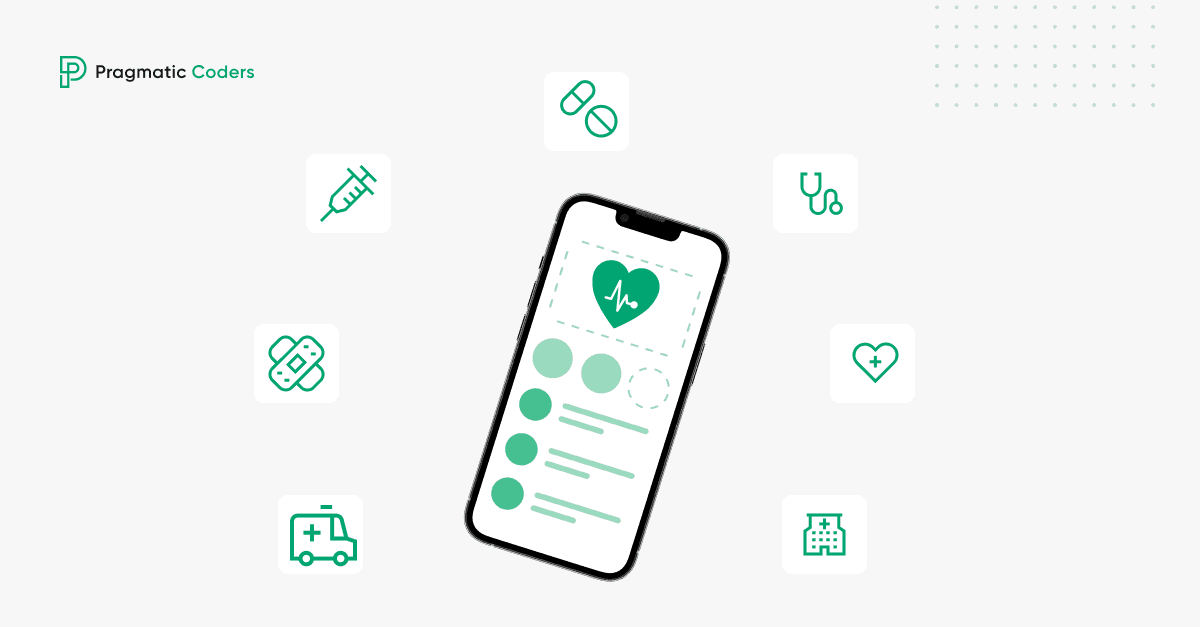
10. Prevention & Predictive Healthcare
With the growing adoption of AI, there has been a shift in healthcare providers’ approach – a focus transition from treating conditions to predicting them through data-driven healthcare.
How is this transformation achievable?
Healthcare providers gather real-time data from Internet of Medical Things (IoMT) devices and other sources. They employ AI-powered predictive analytics and harness big data to facilitate instant medical alerts, customize treatments, forecast disease outcomes, predict patient loads, and efficiently identify at-risk patients.
What initiated this emerging healthcare tech trend?
- Patient stratification, an ongoing data-driven process that assigns risk levels to patients based on crucial health indicators, lifestyle, and medical history, has paved the way for identifying high-cost, high-need patients. This enables tailored care management strategies aimed at addressing urgent healthcare requirements.
- Analytics enable the construction of a comprehensive, personalized patient perspective, with a holistic understanding of each patient’s health journey. This encompasses previous medical interactions and additional data, including social determinants of health (SDoH).
- In the United States, the Affordable Care Act has prioritized value-based care, continuing to incentivize healthcare providers to maintain patient well-being rather than simply escalating interventions and procedures.
It’s worth noting that the prevention trend is not solely driven by a shift in healthcare provider approaches. Young patient demographics, especially Gen Z, are proactively prioritizing their health. According to the Linus Group, Gen Zers allocate a greater portion of their healthcare spending to preventative measures (56%) compared to episodic care (44%), indicating a marked generational shift towards proactive wellness.
Learn more: What does Gen Z want from healthcare?
11. Personalized and Genomic Medicine (+Immortality-as-a-service)
Personalized medicine uses genetic information to tailor medical treatments to an individual’s specific needs.
Real-life examples:
- Cancer Treatment: By analyzing a tumor’s genetic makeup, doctors can select the most effective drugs for each patient.
- Drug Response Prediction: Genetic testing can help predict how a patient will respond to certain medications, preventing adverse reactions and ensuring optimal treatment.
Startup example:
- Freya Biosciences uses genomics to develop treatments for women’s health issues. They analyze genetic information and immune responses to create therapies aimed at conditions like infertility, endometriosis, and preterm birth. Their approach combines data from whole-genome sequencing.
Although this might sound a bit sci-fi compared to the other healthcare technology trends, immortality-as-a-service was one of the 11 tech trends to watch in 2023, according to the CBInsights report.
Tech companies increasingly use AI and genetics to develop products and services that promise to extend human lifespan. While the ultimate goal of immortality may be far-fetched, the potential market for these products is enormous, and age-defying consumers are likely to be a lucrative source of recurring revenue.
How do companies want to make people immortal?
- Altos Labs – a healthcare institution hacking cellular processes to reverse aging and rejuvenate cells.
- Elysium Health – analyzing DNA to find aging-associated markers and measure your biological age.
Learn more: Personalization in healthcare in 2025
12. Digital Therapeutics (+Gamification of health)
Digital therapeutics use evidence-based therapeutic interventions delivered through software to prevent, manage, or treat medical conditions.
Real-life examples:
- Mental Health Apps: Apps that offer cognitive-behavioral therapy (CBT) exercises and mindfulness techniques to help manage anxiety and depression.
- Diabetes Management Apps: Apps that help people with diabetes track their blood sugar levels, calculate insulin doses, and receive personalized lifestyle recommendations.
And what if managing diabetes felt like fun? This is gamification—a strategy that uses game-like elements to make everyday tasks more engaging. While gamification has long been present in sectors like education, it’s making waves in healthcare software development, too.
Examples? TDTX apps for kids
- Triumf Health is a digital therapeutics app for children delivered through a mobile game to improve their mental wellbeing and quality of life.
- Developed by Pfizer, Hemocraft teaches children with hemophilia the importance of following treatment plans by creating a simulated environment where they can learn about their condition and how to handle emergencies before help arrives.
Learn more: Gamification in healthcare
13. Holistic & Whole Person Care
Modern medical practices have shifted towards a more comprehensive approach known as whole-person care. Unlike traditional healthcare, whole person care considers a patient’s entire life story, including past experiences, current interactions, and the influence of social determinants of health (SDoH).
Whole person care goes beyond treating only physical ailments. It emphasizes mental health and emotional well-being, social factors, and overall quality of life. This patient-centered strategy results in personalized care programs that can ultimately reduce healthcare costs.
What drives the holistic health trend?
- Growing recognition of SDoH’s importance. These factors, including living conditions, marital status, and socio-economic, emotional, and cultural background, impact health beyond medical conditions alone. By addressing these factors, healthcare systems can provide more effective medical services.
- Polychronic patient trend is on the rise. The rise of patients with multiple chronic conditions, known as polychronic patients, also underscores the need for this approach. Despite constituting just 5% of the US population, they contribute to 45% of national healthcare costs due to their complex medical needs and frequent healthcare use2.
- Post-COVID behavioral crisis. The aftermath of the COVID-19 pandemic has worsened behavioral health challenges. The economic impact, social isolation, and uncertainty from COVID-19 have exacerbated behavioral health issues, highlighting the importance of holistic healthcare approaches.
Care management software
Healthcare delivery transformation | Digital healthcare market trends

14. Invisible Healthcare/Remote Patient Monitoring
Remote patient monitoring (RPM) – collecting and monitoring patient data from a remote location – was another field that caught society’s attention due to the COVID-19 lockdown. The need to stay home made healthcare providers find new ways to care for patients with fewer in-person visits, resulting in the quick growth of telehealth and remote patient monitoring.
Ambient health monitoring goes beyond standard RPM. As with remote patient monitoring, it uses sensors and medical devices to keep track of our health in our everyday surroundings. However, it does much more than that.
Ambient means existing or present on all sides, and it evokes the concept of ambient music, a genre designed to provide unobtrusive accompaniment to other activities1. In a similar vein, ambient intelligence in healthcare aims to offer 100% continuous and minimally invasive tracking, making it more apparent and accessible than ever before.
The ambient health technology trend is expanding in a few areas, including precision health, senior care, biomarkers, and smart stickers. Here are a few examples:
- Sensi.AI is an Israel-based remote care monitoring platform monitoring the health and well-being of seniors in their homes. The platform uses audio data from sensors in the house, such as smart speakers, smartphones, and security cameras, to detect daily activities, including eating meals and taking showers.
- Nobi is a stylish smart lamp produced in Belgium. The Nobi lamps use artificial intelligence (move detection) to detect falls, turn on lights, and alert care staff in case of a patient’s inactivity.
- Kintsugi Voice is an API-first platform that uses novel voice biomarkers in speech to identify, prioritize, and care for mental health in real time.
- Ellipsis Health harnesses machine learning to generate a clinical-grade assessment of the severity of anxiety and depression.
Considering the ongoing healthcare trend to make health monitoring an unnoticeable process, the key focus for upcoming years will be addressing the question: How to create a seamless combination of continuous medical data collection and user-friendly digital technology that requires minimal patient involvement?
Learn more: Ambient intelligence in healthcare
15. Decentralized Clinical Trials
Decentralized clinical trials (DCTs) are clinical trials that utilize technology to allow participants to complete study procedures remotely, such as at home or at local clinics.
Background: Traditional clinical trials often require participants to travel to a clinical site, which can be inconvenient and limit participation. DCTs aim to improve patient experience and broaden access to clinical trials.
Real-life examples:
- Remote data capture: Participants can use mobile apps to record symptoms, take measurements, and submit data directly to the study team.
- Telemedicine consultations: Virtual visits with study physicians allow for remote monitoring and assessment.
Startup example:
- Science 37: Science 37 is a clinical research company specializing in decentralized clinical trials. Their Metasite™ platform enables patients to participate in clinical studies from their homes.
Learn more: Advantages & disadvantages of telemedicine
16. Healthcare Ecosystem Orchestration
Healthcare Ecosystem Orchestration involves coordinating and integrating various healthcare stakeholders, including providers, payers, patients, and technology companies, to optimize care delivery and improve health outcomes.
Background: The healthcare industry is complex and fragmented, often leading to inefficiencies and poor patient experiences. Ecosystem orchestration aims to break down silos and create a more connected and patient-centric healthcare system.
Real-life Examples:
- Value-Based Care: Healthcare organizations are shifting from fee-for-service to value-based care models, which incentivize quality outcomes and cost-effectiveness.
- Population Health Management: By analyzing large datasets, healthcare providers can identify and address the needs of specific patient populations.
Startup Example:
- Health Catalyst: This company provides data and analytics solutions to help healthcare organizations improve quality and reduce costs.
What’s more, according to Dealroom, there’s a need for shoppable healthcare experience. We have grown accustomed to the traditional way healthcare is delivered. However, research shows that people no longer want to settle for public health standards. They want healthcare experiences that are user-centric, personalized, and shoppable, just like the ones they have on Facebook.
In case of the US, the catalyst behind this trend was partly the adoption of the Interoperability and Patient Access Final Rules that give providers and patients greater access to health information.
Providers can now access patient data more easily and quickly, and patients can access their health information through a secure portal. The rules also require that electronic health records (EHR) and ambulatory medical records data be shared seamlessly with claims systems.
How do businesses create engaging and personalized healthcare experiences?
- BetaCare , a telemedicine platform in Nigeria, has launched a WhatsApp chatbot to provide patients with virtual consultations with expert doctors of various specialties. WhatsApp is the leading messaging platform in the country, so BetaCare chose it to reach a wider audience.
- Caligenix , a genetic wellness company, has launched personalized skincare and nutrition brands that use cutting-edge technology to match patients’ genomic DNA with the right products.
Patient engagement app development
Specialized care focus | Digital healthcare market trends

17. Women’s Health Technology
The global women’s health market is expected to increase from $44.82 billion in 2023 to $58.69 billion by 2028, growing at a compound annual growth rate (CAGR) of 5.54% over the forecast period.4.
Statistics show a growing interest in and investment in women’s health. This is due to a number of factors, including the aging population, the increasing prevalence of chronic diseases, and the growing awareness of the importance of women’s health. At the same time, more and more businesses see the potential in the currently underserved market of women’s health services.
Companies target various aspects of women’s health and wellness: benefits & financing, cancer, sexual health, maternal health, primary care, mental health, menopause, and fertility. Among them, the last two seem especially prominent.
Femtech turns to menopause
The transition to menopause can be associated with a variety of distressing symptoms. These symptoms include cognitive impairment, hot flashes, sweating, and insomnia. Despite the significance of this natural phase, there is limited access to formal education and medical treatment options for women.
As the women’s health space continues to grow, many startups specifically cater to women going through menopause.
- Alloy offers telehealth-driven menopause prescription service focusing on plant-based hormone therapies;
- Vira Health provides AI-backed digital therapeutics for menopause;
- Fifty One Apparel creates advanced clothing materials that regulate temperature to help women manage menopause symptoms.
Fertility services
A lot of women are choosing to become mothers when they are older and looking into their fertility options. This is creating a more immense need for reproductive healthcare that is both creative and comprehensive.
- Hertility provides an algorithm that analyses 1500+ data points to create a personalized hormone panel. This, in turn, lets women better understand how their hormones are impacting their fertility.
- Univfy generates reports enabling women to see their personalized probability of success with IVF and other treatments.
18. Senior Care Technology
By 2060, the number of Americans age 65 and older is expected to almost double to 95 million, from 52 million in 2018. This age group’s share of the total population is also projected to increase from 16% to 23%.5.
The statistics regarding senior health leave no doubts – healthcare services for older people are a dynamically growing market that won’t stop anytime soon.
Healthcare organizations are increasingly investing in technologies that can help seniors age in place and maintain their independence. How? Go back to trend #3, where we talked about ambient health monitoring systems, and check the two examples below.
- ElliQ , a small robot developed by Intuition Robotics, is designed to support and accompany older adults on the journey to age independently while reducing loneliness and isolation. ElliQ uses artificial intelligence AI to engage in natural-sounding conversations with users, such as making jokes, playing games, and offering suggestions to promote healthy habits.
- CarePredict combines wearable technology, intelligent indoor location tracking, deep machine learning, and predictive analytics. When minor irregularities arise, or shifts in an individual’s behavior are noticed (like slower walking or increased nighttime awakenings), the system notifies caregivers. This allows them to intervene proactively before these concerns escalate into significant health issues.
19. Equitable Healthcare Solutions
The pandemic has brought a renewed focus on health equity, prompting ongoing actions even as the crisis abates. COVID-19 highlighted health disparities, particularly affecting communities of color and underserved groups, making them more vulnerable to the virus’s impact.
Although these disparities existed previously, the pandemic’s constant media coverage underscored their prevalence, emphasizing the need for action.
Healthcare providers understand that equity benefits everyone, as equal access to care lowers severe cases and hospitalizations, making the healthcare system more effective.
- CINQCARE serves as an example of a healthcare company successfully implementing the equitable healthcare principle. CINQCARE is a provider-led, community-based comprehensive healthcare delivery partner. Their purpose is to improve the health and well-being of patients in their homes and communities – with a deep commitment to Black and Brown people.
Digital healthcare market trends. Summary
The healthcare technology landscape of 2025 shows clear patterns of what drives real value. For even more insight, check Top 10 most promising startups to watch in 2025. Some of the companies mentioned there are driving trends like precision medicine, affordable healthcare, and mental health innovation.
For healthcare leaders, the message is clear: invest in solutions that solve real problems, measure their impact rigorously, and focus on technologies that augment rather than replace human capabilities.
Looking for a reliable healthcare software development partner? Check our digital health software development services or get a quote right away.






